1994 CHEVROLET CAVALIER run flat
[x] Cancel search: run flatPage 7 of 243
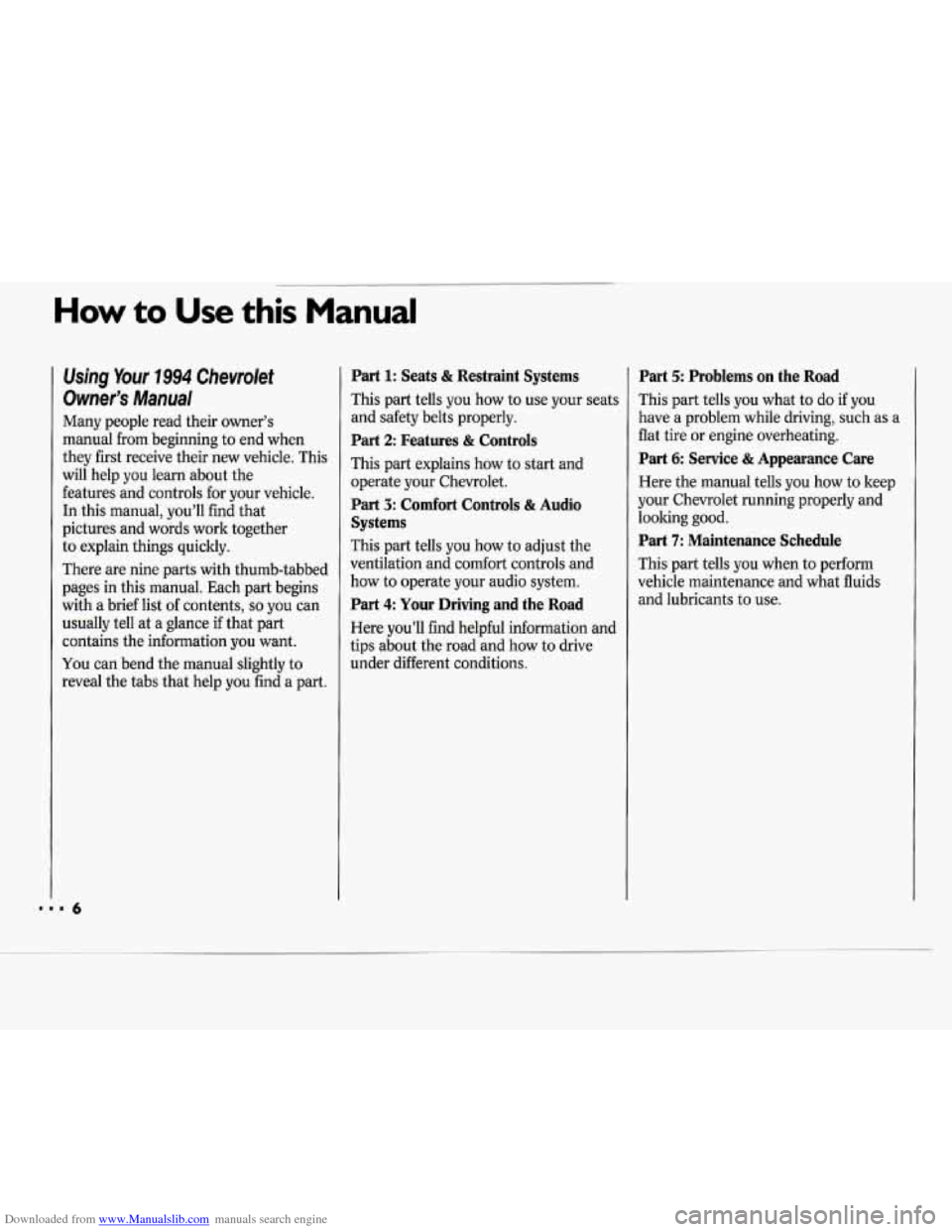
Downloaded from www.Manualslib.com manuals search engine Using Your 7994 Chevrolet
Owner’s Manual
Many people read their owner’s
manual
from beginning to end when
they first receive their new vehicle. This
will help you learn about the
features and controls for your vehicle.
In this manual, you’ll find that
pictures and words work together
to explain things quickly.
There are nine parts with thumb-tabbed
pages in this manual. Each part begins
with a brief list of contents,
so you can
usually tell at a glance if that part
contains the information you want.
You can bend the manual slightly to
reveal the tabs that help you find a part.
Part 1: Seats & Restraint Systems
This part tells you how to use your seats
and safety belts properly.
Part 2 Features & Controls
This part explains how to start and
operate your Chevrolet
.
Part 3: Comfort Controls & Audio
Systems
This part tells you how to adjust the
ventilation and comfort controls and
how to operate your audio system.
Part 4 Your Driving and the Road
Here you’ll find helpful information and
tips about the road and how
to drive
under different conditions.
Part 5: Problems on the Road
This part tells you what to do if you
have a problem while driving, such as a
flat tire or engine overheating.
Part 6: Service & Appearance Care
Here the manual tells you how to keep
your Chevrolet running properly and
looking good.
Part 7: Maintenance Schedule
This part tells you when to perform
vehicle maintenance and what fluids
and lubricants to use.
Page 50 of 243
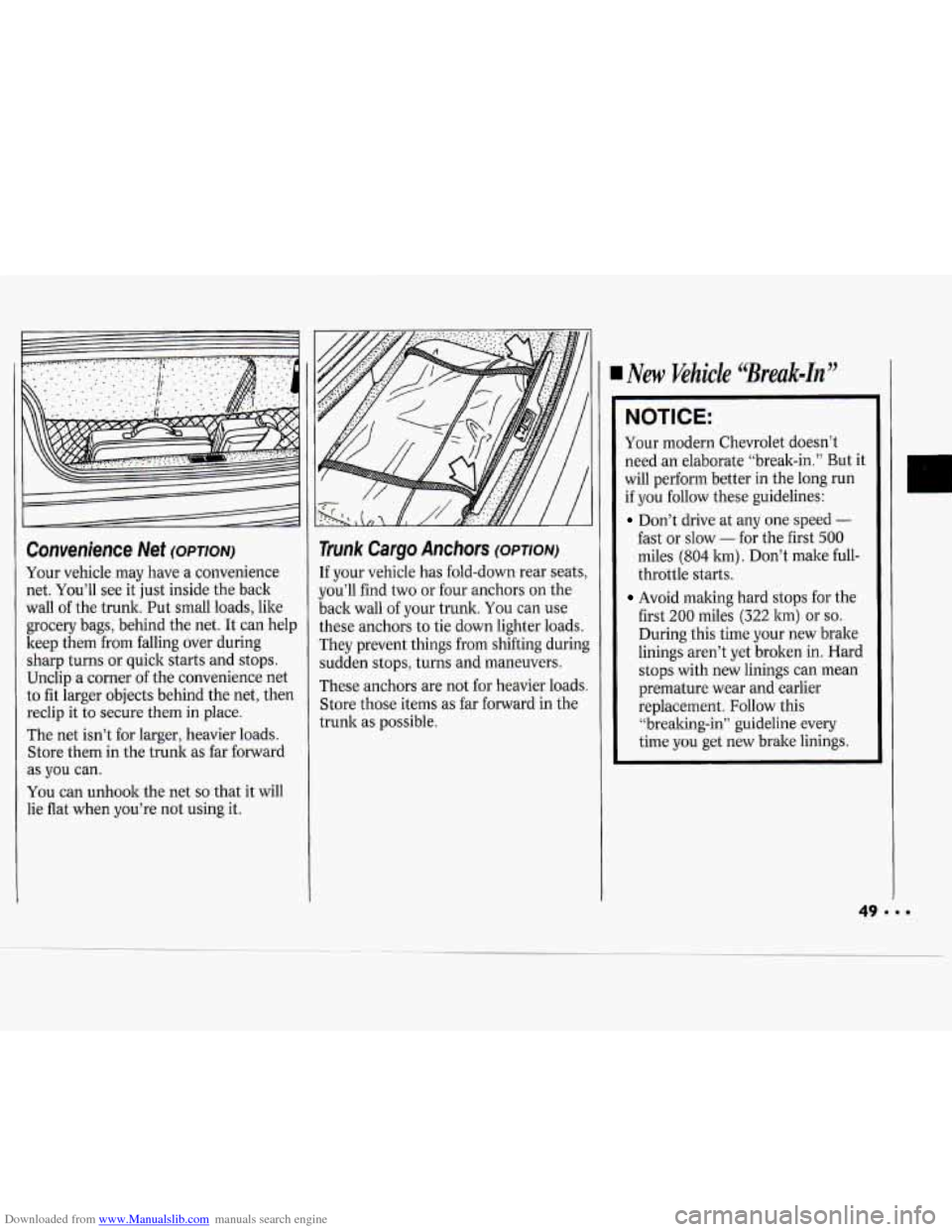
Downloaded from www.Manualslib.com manuals search engine Convenience Net (OPTION)
Your vehicle may have a convenience
net. You’ll see it just inside the back
wall of the trunk. Put small loads, like
grocery bags, behind the net. It can help
keep them
from falling over during
sharp turns or quick starts and stops.
Unclip a corner of the convenience net
to fit larger objects behind the net, then
reclip it to secure them in place.
The net isn’t for larger, heavier loads.
Store them in the trunk as far forward
as
you can.
You can unhook the net
so that it will
lie flat when you’re not using it.
Trunk Cargo Anchors (OPTION)
If your vehicle has fold-down rear seats,
you’ll find two or four anchors on the
back wall of your trunk.
You can use
these anchors to tie down lighter loads.
They prevent things from shifting during
sudden stops, turns and maneuvers.
These anchors are not for heavier loads.
Store those items as far forward in the
trunk as possible.
New Khicle ‘Break-in"
NOTICE:
Your modern Chevrolet doesn’t
need an elaborate “break-in.” But it
will perform better in the long run
if you follow these guidelines:
Don’t drive at any one speed -
fast or slow - for the fist 500
miles (804 km) . Don’t make full-
throttle starts.
Avoid making hard stops for the
first
200 miles (322 km) or so.
During this time your new brake
linings aren’t yet broken in. Hard
stops with new linings can mean
premature wear and earlier
replacement. Follow this
“brealring-in” guideline every
time you get new brake linings.
Page 146 of 243
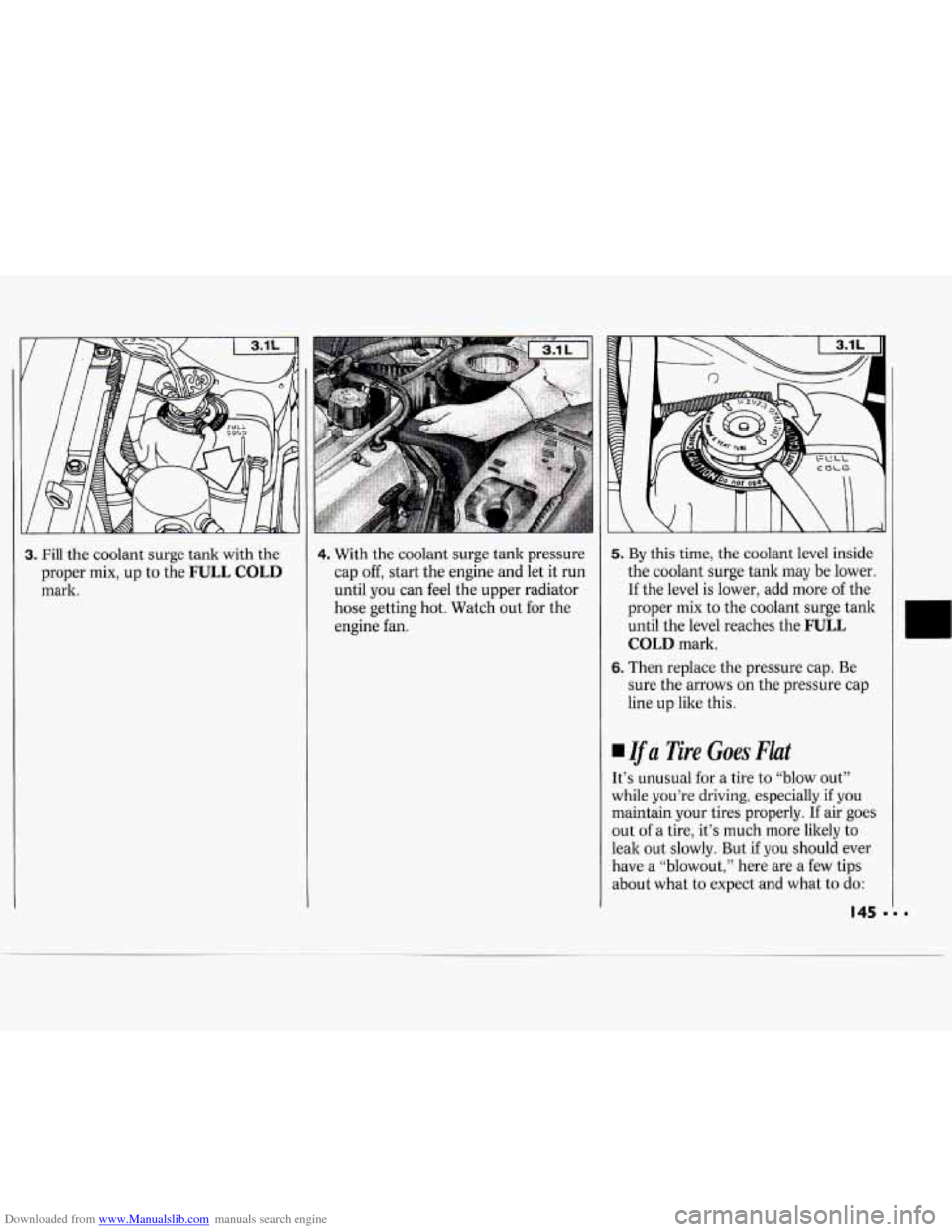
Downloaded from www.Manualslib.com manuals search engine 3. Fill the coolant surge tank with the
proper mix, up to the
FULL COLD
mark.
4. With the coolant surge tank pressure
cap
off, start the engine and let it run
until you can feel the upper radiator
hose getting hot. Watch out for the
engine fan.
5. By this time, the coolant level inside
the coolant surge tank may be lower.
If the level is lower, add more of the
proper mix to the coolant surge tank
until the level reaches the
FULL
COLD mark.
6. Then replace the pressure cap. Be
sure the arrows
on the pressure cap
line up like this.
Ifa Tire Goes Flat
It’s unusual for a tire to “blow out”
while you’re driving, especially
if you
maintain your tires properly. If air goes
out of a tire, it’s much more likely to
leak out slowly. But
if you should ever
have a
blowout^" here are a few tips
about what to expect and what
to do:
Page 147 of 243
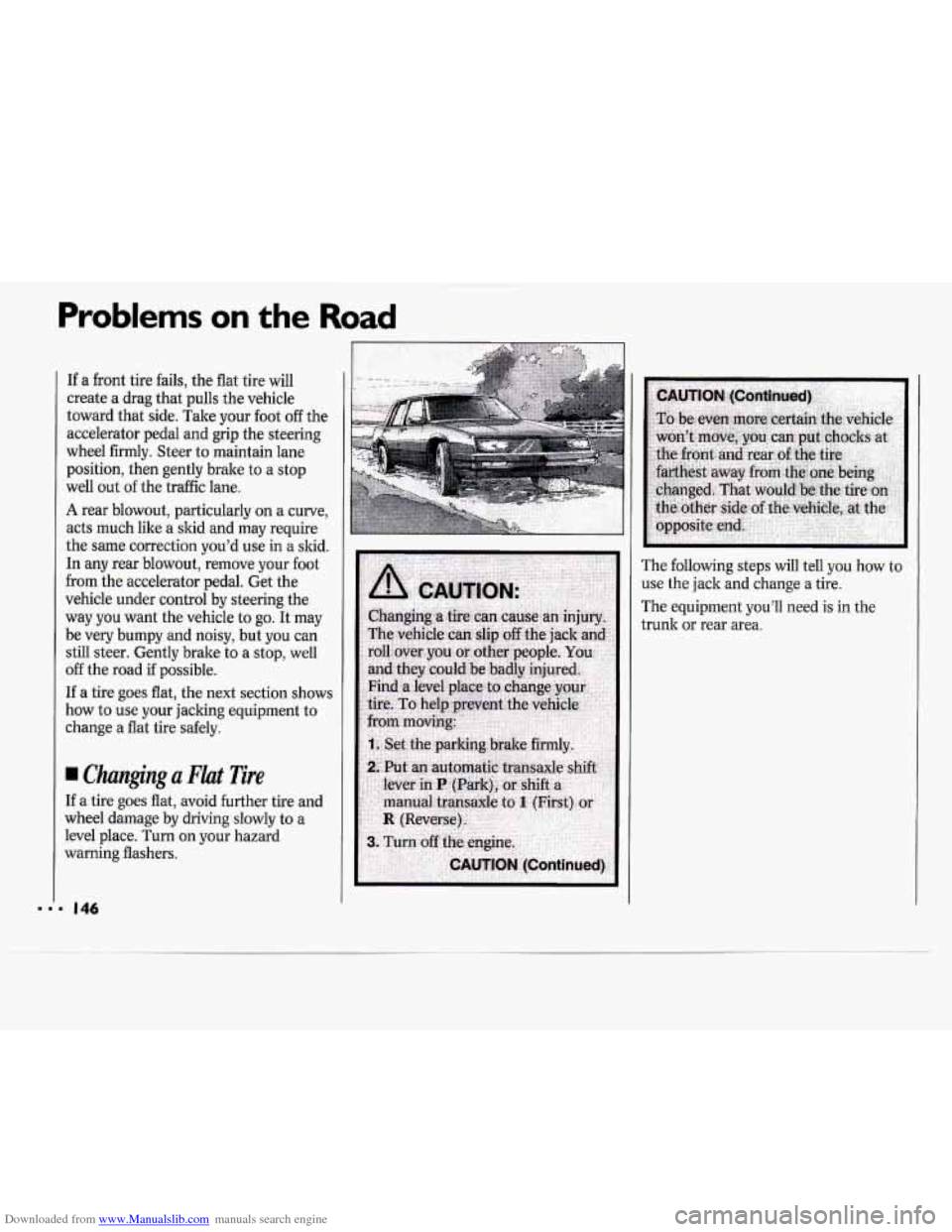
Downloaded from www.Manualslib.com manuals search engine Problems on the Road
If a front tire fails, the flat tire will
create a drag that pulls the vehicle
toward that side. Take your foot off the
accelerator pedal and grip the steering
wheel firmly. Steer to maintain lane
position, then gently brake to
a stop
well out
of the traffic lane.
A rear blowout, particularly on a curve,
acts much like a skid and may require
the same correction you’d use in a skid.
In any rear blowout, remove your foot
from the accelerator pedal. Get the
vehicle under control by steering the
way
you want the vehicle to go. It may
be very bumpy and noisy, but you can
still steer. Gently brake to a stop, well
off the road if possible.
If a tire goes flat, the next section shows
how to use your jacking equipment to
change a flat tire safely.
Changing a Flat Tire
If a tire goes flat, avoid further tire and
wheel damage by driving slowly to a
level place. Turn on your hazard
warning flashers. The
following steps will tell you how to
use the jack and change a tire.
The equipment you’ll need
is in the
trunk
or rear area.
Page 152 of 243
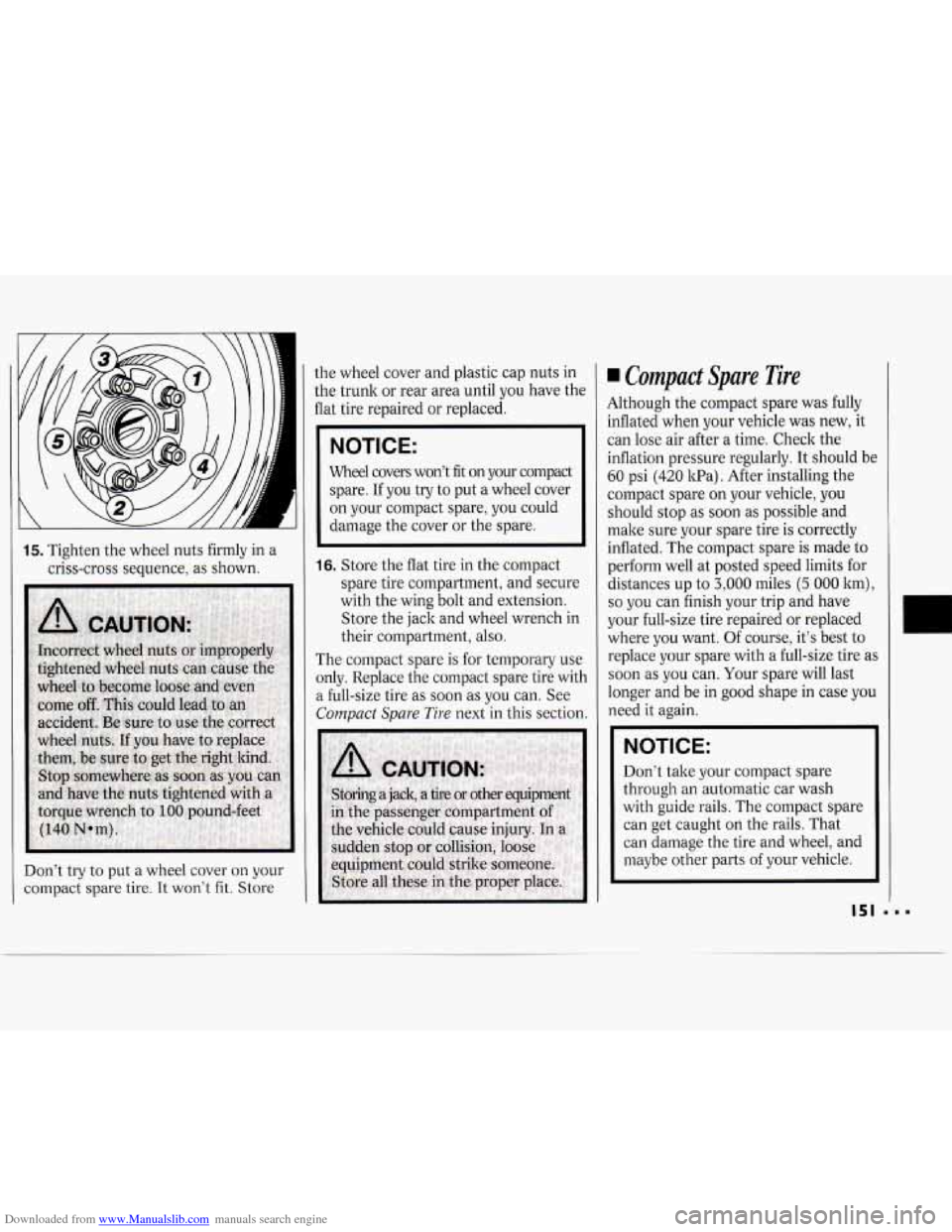
Downloaded from www.Manualslib.com manuals search engine 15. Tighten the wheel nuts firmly in a
criss-cross sequence, as shown.
Don’t try to put a wheel cover
on your
compact spare tire.
It won’t fit. Store the
wheel cover and plastic cap nuts in
the trunk or rear area until you have the
flat tire repaired or replaced.
IICE: I
Wheel covers won’t fit on your compact
spare. If you try to put a wheel cover
on your compact spare, you could
damage the cover or the spare.
16. Store the flat tire in the compact
spare tire compartment, and secure
with the wing bolt and extension.
Store the jack and wheel wrench in
their compartment, also.
The compact spare
is for temporary use
only. Replace the compact spare tire with
a full-size tire as soon as you can. See
Compact Spare Tire next in this section.
Compact Spare Tire
Although the compact spare was fully
inflated when your vehicle was new, it
can lose air after a time. Check the
inflation pressure regularly. It should be
60 psi (420 1cPa). After installing the
compact spare on your vehicle, you
should stop as soon as possible and
make sure your spare tire is correctly
inflated. The compact spare is made
to
perform well at posted speed limits for
distances up to
3,000 miles (5 000 lcm),
so you can finish your trip and have
your full-size tire repaired or replaced
where you want. Of course, it‘s best
to
replace your spare with a full-size tire as
soon as
you can. Your spare will last
longer and be in good shape in case you
need it again.
NOTICE:
Don’t take your compact spare
through an automatic car wash
with guide rails. The compact spare
can get caught on the rails. That
can damage the tire and wheel, and
maybe other parts
of your vehicle.
151
Page 181 of 243
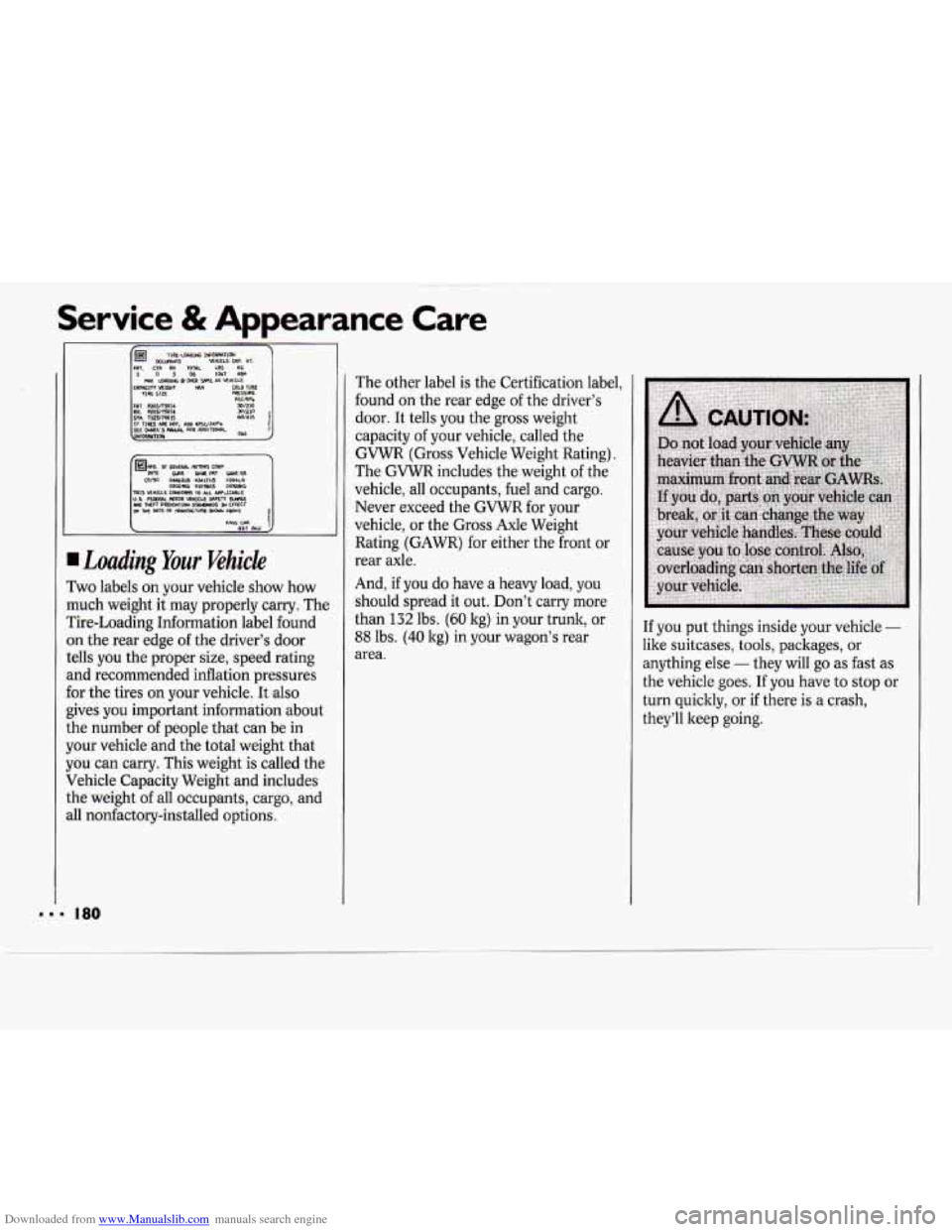
Downloaded from www.Manualslib.com manuals search engine Service & Appearance Care
I Loading Your Vehicle
Two labels on your vehicle show how
nuch weight it may properly carry. The
rire-Loading Information label found
In the rear edge of the driver's door
.ells you the proper size, speed rating
md recommended inflation pressures
or the tires on your vehicle. It also
:ives you important information about
.he number of people that can be in
four vehicle and the total weight that
rou can carry. This weight
is called the
Jehicle Capacity Weight and includes
.he weight
of all occupants, cargo, and
111 nonfactory-installed options. The other label is
the Certification label,
found on the rear edge of the driver's
door. It tells you the gross weight
capacity of your vehicle, called the
GVWR (Gross Vehicle Weight Rating).
The
GVWR includes the weight of the
vehicle, all occupants, fuel and cargo.
Never exceed the GVWR for your
vehicle,
or the Gross Axle Weight
Rating (GAWR) for either the front or
rear axle.
And, if you do have a heavy load, you
should spread it out. Don't carry more
than
132 lbs. (60 kg) in your trunk, or
88 lbs. (40 kg) in your wagon's rear
area. If you put things inside your vehicle -
like suitcases, tools, packages, or
anything else
- they will go as fast as
the vehicle goes. If you have to stop or
turn quicltly, or
if there is a crash,
they'll keep going.
Page 236 of 243
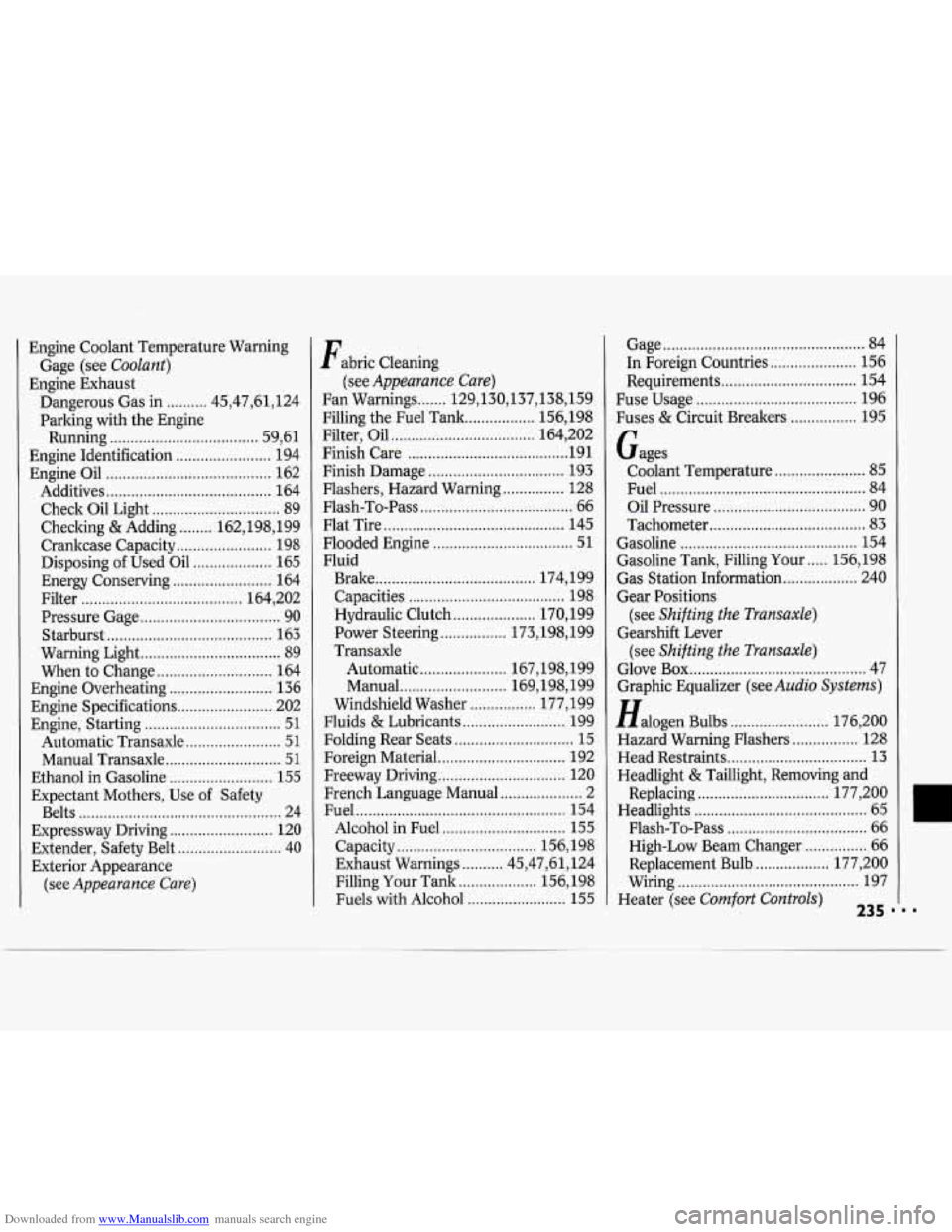
Downloaded from www.Manualslib.com manuals search engine Engine Coolant Temperature Warning
Engine Exhaust Gage (see
Coolant)
Dangerous Gas
in .......... 45.47.61. 124
Parking with the Engine
Running
.................................... 59. 61
Engine Identification
....................... 194
Engine Oil
........................................ 162
Additives
........................................ 164
Check Oil Light
............................... 89
Checking &Adding
........ 162.198. 199
Crankcase Capacity
....................... 198
Disposing of Used Oil
................... 165
Energy Conserving
........................ 164
Filter
....................................... 164. 202
Pressure Gage
.................................. 90
Starburst
........................................ 163
Warning Light
.................................. 89
When to Change
............................ 164
Engine Overheating
......................... 136
Engine Specifications ....................... 202
Engine. Starting
................................. 51
Automatic Transaxle
....................... 51
Manual Transaxle
............................ 51
Ethanol in Gasoline
......................... 155
Expectant Mothers. Use
of Safety
Belts
................................................. 24
Extender. Safety Belt
......................... 40
Exterior Appearance
Expressway Driving
......................... 120
(see Appearance
Care)
Fabric Cleaning
Fan Warnings
....... 129.130.137.138. 159
Filling the Fuel Tank
................. 156. 198
Filter. Oil
................................... 164, 202
Finish Care
....................................... 19 1
Finish Damage ................................. 193
Flashers, Hazard Warning
............... 128
Flash-To-Pass
..................................... 66
Flat Tire
............................................ 145
Flooded Engine
.................................. 51
Fluid Brake
....................................... 174, 199
Capacities
...................................... 198
Hydraulic Clutch
.................... 170. 199
Power Steering
................ 173,198, 199
Transaxle Automatic
..................... 167,198, 199
Manual
.......................... 169,198, 199
Windshield Washer
................ 177, 199
Fluids
& Lubricants ......................... 199
Foreign Material
............................... 192
Freeway Driving
............................... 120
French Language Manual
.................... 2
Fuel
................................................... 154
Alcohol in Fuel
.............................. 155
Capacity
.................................. 156, 198
Exhaust Warnings
.......... 45,47,61, 124
Filling Your Tank
................... 156, 198
Fuels with Alcohol
........................ 155
(see
Appearance
Care)
Folding Rear Seats ............................. 15
Gage ................................................. 84
In Foreign Countries ..................... 156
Requirements
................................. 154
Fuse Usage
....................................... 196
Fuses
& Circuit Breakers ................ 195
Gages Coolant Temperature
...................... 85
Fuel .................................................. 84
Oil Pressure
..................................... 90
Tachometer
...................................... 83
Gasoline ........................................... 154
Gasoline Tank, Filling Your
..... 156, 198
Gas Station Information
.................. 240
Gear Positions
Gearshift Lever
Glove Box
........................................... 47
Graphic Equalizer (see
Audio Systems)
Halogen Bulbs ........................ 176, 200
Head Restraints
.................................. 13
Headlight & Taillight, Removing and
(see
Shifting
the Transaxle)
(see Shifting the Transaxle)
Hazard Warning Flashers ................ 128
Replacing
................................ 177, 200
Headlights
.......................................... 65
Flash-To-Pass
.................................. 66
High-Low Beam Changer
............... 66
Replacement Bulb
.................. 177, 200
Wiring
............................................ 197
Heater (see
Comfort Controls) 235 1 . .
Page 237 of 243
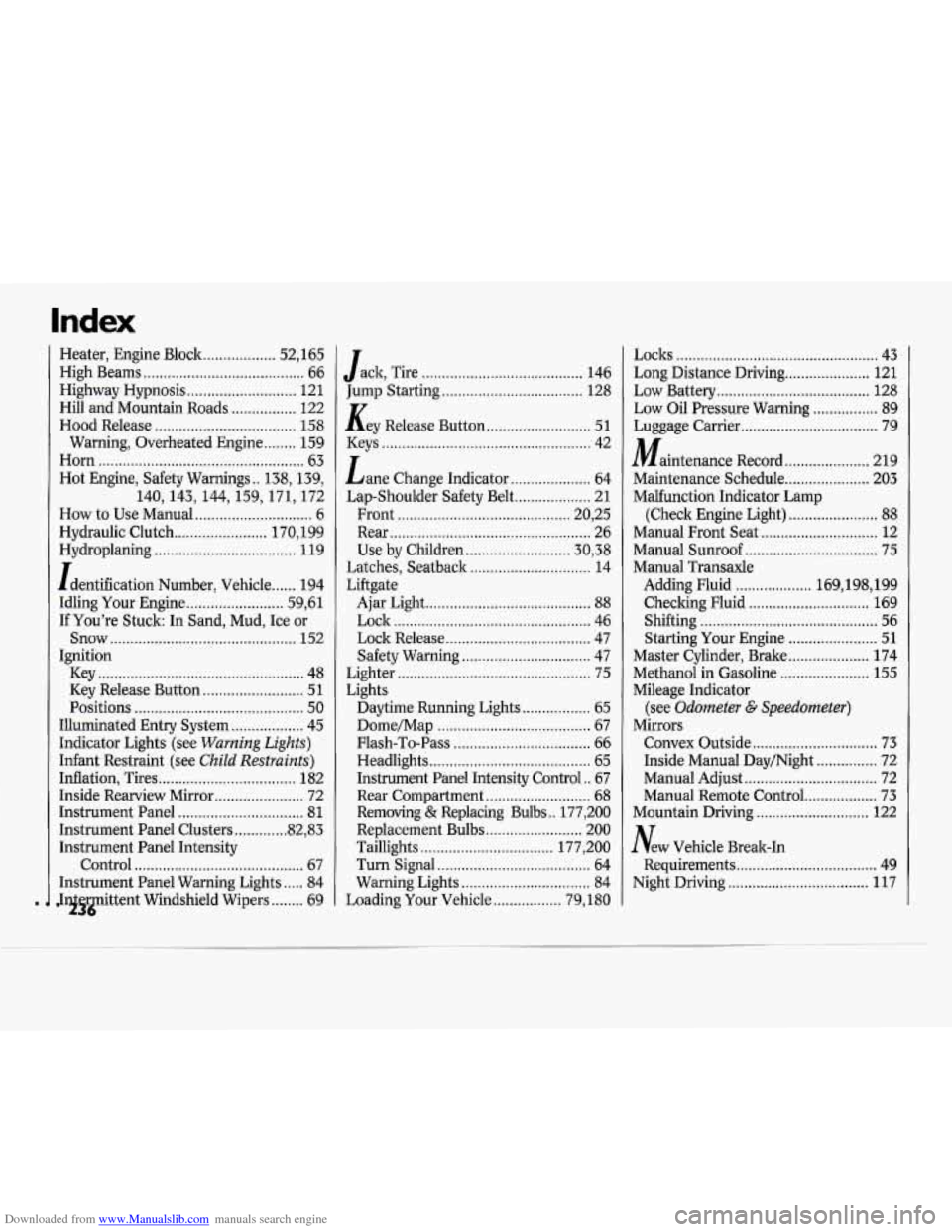
Downloaded from www.Manualslib.com manuals search engine Heater. Engine Block .................. 52. 165
High Beams ........................................ 66
Highway Hypnosis
........................... 121
Hill and Mountain Roads
................ 122
Hood Release
................................... 158
Warning. Overheated Engine
........ 159
Horn
................................................... 63
Hot Engine. Safety Warnings
.. 138. 139.
140.143.144.159.171. 172
How to Use Manual ............................. 6
Hydraulic Clutch
....................... 170. 199
Hydroplaning
................................... 1 19
Identification Number. Vehicle
...... 194
If You're Stuck: In Sand. Mud. Ice or
Ignition Idling Your Engine
........................ 59. 61
Snow .............................................. 152
Key
................................................... 48
Key Release Button
......................... 51
Positions
.......................................... 50
Illuminated Entry System
.................. 45
Indicator Lights (see
Warning Lights)
Infant Restraint (see Child Restraints)
Inflation. Tires .................................. 182
Inside Rearview Mirror
...................... 72
Instrument Panel
............................... 81
Instrument Panel Clusters ............. 82. 83
Instrument Panel Intensity
Control
.......................................... 67
Instrument Panel Warning Lights 84
ittent Windshield Wipers 69
.....
.'95iP ........
Jack. Tire ........................................ 146
Key Release Button .......................... 51
Jump Starting
................................... 128
Keys
.................................................... 42
Lap-Shoulder Safety Belt
................... 21
Use by Children
.......................... 30'38
Latches, Seatback
.............................. 14
Liftgate
Lane
Change Indicator
.................... 64
Front
........................................... 20, 25
Rear .................................................. 26
Ajar Light
......................................... 88
Lock ................................................. 46
Lock Release
.................................... 47
Safety Warning
................................ 47
Lighter
................................................ 75
Lights Daytime Running Lights
................. 65
Dome/Map ...................................... 67
Flash-To-Pass
.................................. 66
Headlights
........................................ 65
Instrument Panel Intensity Control
.. 67
Rear Compartment
.......................... 68
Removing & Replacing Bulbs .. 177, 200
Replacement Bulbs
........................ 200
Taillights
................................. 177, 200
Turn Signal
...................................... 64
Warning Lights
................................ 84
Loading Your Vehicle
................. 79, 180 Locks
.................................................. 43
Long Distance Driving
..................... 121
Low Battery
...................................... 128
Low Oil Pressure Warning
................ 89
Maintenance Record ..................... 219
Maintenance Schedule
..................... 203
Malfunction Indicator Lamp
(Check Engine Light)
...................... 88
Manual Front Seat ............................. 12
Manual Sunroof
................................. 75
Manual Transaxle
Luggage
Carrier
.................................. 79
Adding Fluid
................... 169,198, 199
Checking Fluid
.............................. 169
Shifting
............................................ 56
Starting Your Engine
...................... 51
Master Cylinder. Brake
.................... 174
Methanol in Gasoline
...................... 155
Mileage Indicator
Mirrors (see
Odometer G Speedometer)
Convex
Outside ............................... 73
Inside Manual Day/Night
............... 72
Manual Adjust
................................. 72
Manual Remote Control
.................. 73
Mountain Driving
............................ 122
New Vehicle Break-In
Requirements
................................... 49
Night Driving ................................... 117